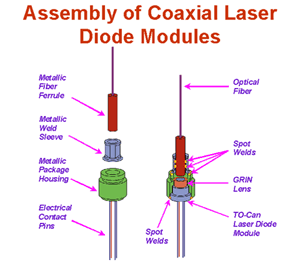
Optical components are tiny, complex devices that form the backbone behind telecommunication networks. Devices are assembled into a package or module that couples the light into or out of fiber optic cable.
Two classes of fiber optic components exist: active and passive. Active components consist of the semiconductor laser technology that is necessary to provide the light in a fiber optic network. These devices are generally easier to assemble. They require the integration of electronics and wiring into a package using traditional assembly technologies, such as soldering and die- and wire-bonding techniques. Receivers, transmitters, modulators, amplifiers and switches are examples of active components.
Passive components operate on the light passing through the fiber and do not require power or electronics. Their function is to filter, divide or combine the light signals traveling through the optical fiber. These components are much more labor intensive and costly to manufacture. Passive devices include couplers, isolators, and wavelength division multiplexers and demultiplexers.
Optical components are made of many different types of materials, such as gallium arsenide, indium phosphate, lithium niobate, silicon and zirconia. Last year, researchers at the University of Washington developed an electro-optic polymer for making optical components.
Up until now, the big problem with using polymers for optical applications has been high light losses and poor thermal and photochemical stability. However, the university scientists claim their material offers improved signal quality and lower optical losses, which enable faster switching speeds.
Right now, many components are expensive because technologies are new and manufacturing processes aren't well developed. In addition, demand is outstripping supply, keeping prices high.
Certain key components remain inefficient, hindering the expansion of fiber optic networks. One of these devices is called an optical splitter. It splits the light traveling along a single transmission line into several new lines so that the signal can be distributed to customers.
Splitting the light results in a large loss of light intensity and signal quality. A typical splitter divides the light from a single optical fiber into 16 new lines, losing 94 percent of the light intensity in the process. To counteract this loss, fiber optic networks must use expensive optical-power boosting amplifiers.
The fastest-growing components are devices used to make dense wavelength division multiplexing (DWDM) gear, which increases the number of wavelengths on a single beam of light. With DWDM technology, 6.4 terabits of data per second can be transmitted over a single fiber, which is a 3,000-fold increase over what was possible in the past.
Component manufacturers are under tremendous pressure to introduce higher and higher capacity DWDM systems. Rapidly growing demand for DWDM-based bandwidth has created a corresponding increase in demand for high-performance components, such as optical amplifiers and pump lasers.
Analysts at RHK Inc. (South San Francisco, CA) predict the market for DWDM systems will skyrocket from $5 billion in 2000 to $24 billion by 2004. During the next 12 months alone, the DWDM optical component market will grow 90 percent.
"Next-generation optical networking is the hottest segment in the industry today," says Elizabeth Bruce, an optical components analyst at the Aberdeen Group Inc. (Boston). When fully implemented, all-optical networks are expected to deliver vast amounts of information unimpeded by the bottlenecks of conventional transport systems. With an all-optical network, information can be carried via light particles from PC to PC without ever having to be converted to electrical signals.
One of the key elements of the all-optical network is the all-optical switch. This device uses microscopic mirrors--more than 250 mirrors fit on a 1-square-inch chip--and lasers that can be tuned to pump out different colors of light. Many of today's switches must first convert optical signals into electrical signals, read them, process them and then convert them back to optical signals before sending them on their way. That conversion causes bottlenecks that slow down the routing process.
Lucent Technologies Inc. (Murray Hill, NJ) recently unveiled the world's first high-capacity, all-optical switch. The WaveStar LambdaRouter is capable of routing more than 10 trillion bits of information per second. That's the equivalent of nearly 2,000 CD-ROMs or 2 billion one-page e-mails. Early this year, Lucent plans to unveil an even faster router that contains 1,024 mirrors.
Other companies, such as Corvis Corp. (Columbia, MD) and Nortel Networks Corp. (Brampton, Ontario), have also developed all-optical switches.

